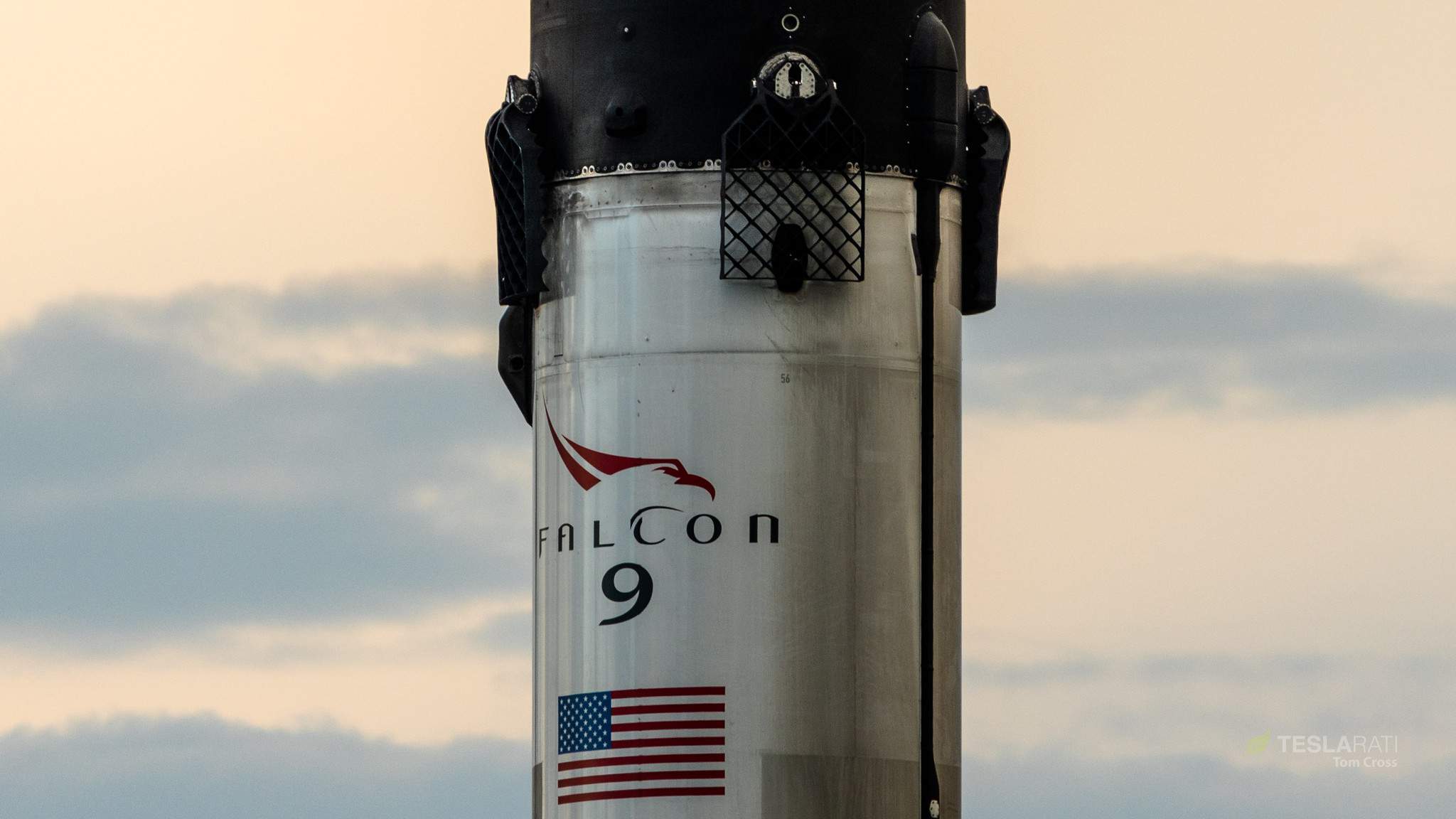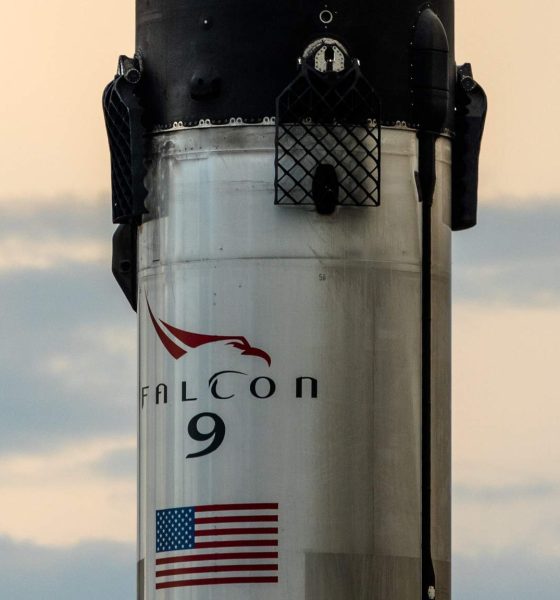

News
SpaceX’s latest Falcon 9 booster returns to port as NASA hints at “vested interest”
SpaceX has safely returned Falcon 9 booster B1056 to port and lifted the rocket ashore after successfully supporting Cargo Dragon’s 18th mission to the International Space Station (ISS).
B1056’s safe return is by no means a surprise, but it is still a relief after mild issues caused Falcon Heavy center core B1055 to topple over just a few weeks prior. SpaceX’s robotic “Octagrabber” was visibly attached to newest Falcon 9 booster, taking advantage of compatibility not available to the Falcon Heavy core. According to NASA and SpaceX, the booster’s recovery was weighing on the minds of both stakeholders thanks to interest in reusing B1056 on future Cargo Dragon launches.
“Quite frankly, [NASA] had a vested interest.”
“Quite frankly, [NASA] had a vested interest in this particular booster. We were gonna require it – the intent is to [reuse it for SpaceX’s upcoming CRS-18 launch] and – potentially – CRS-19.”
Kenny Todd, ISS Operations and Integration Manager, NASA Johnson
Intertwined with SpaceX successfully returning the booster to shore, NASA ISS manager Kenny Todd provided some fascinating and eloquent insight into the space agency’s position on the mission. Several questions from members of the press centered around a launch scrub that pushed CRS-17 from May 3-4. SpaceX VP of Flight Reliability Hans Koenigsmann noted that SpaceX is moving to a concept of operations where booster recovery is just as important and just as necessary as any other technical aspect of launch.
In other words, when SpaceX drone ship Of Course I Still Love You (OCISLY) suffered a rare hardware failure that hobbled its redundant power supplies, NASA had no qualms with the company’s decision to scrub the launch attempt. In fact, confirming educated speculation previously published on Teslarati, NASA had a “vested interest” in the successful recovery of B1056. According to Todd’s comments, NASA unequivocally wants SpaceX to fly its next Cargo Dragon mission – CRS-18, NET mid-July – on the newly flight-proven booster. NASA is even open to flying on B1056 for a third time on CRS-19, pending the condition and availability of the booster.
Unique in SpaceX’s Falcon 9 Block 5 fleet thanks to an exceptionally gentle reentry and recovery, B1056 should easily lend itself to multiple reuses in support of future NASA missions. In fact, of the three (up to as many as five) additional CRS1 Cargo Dragon missions still on contract, there is no immediate technical reason to assume that Falcon 9 B1056 can’t be involved in a majority of those launches, if not all of them. NASA, of course, has the final say in which Falcon 9s their missions launch on, but the agency’s apparent openness to launching on a twice-flown booster opens the door for thrice-flown boosters and beyond.
Space oddities and Falcon curiosities
B1056’s return also offered a unique – if not unprecedented – glimpse of what was likely a purge of TEA/TEB, the pyrophoric fluids Falcon 9 uses to ignite its Merlin engines. Normally, SpaceX recovery technicians likely perform this purge while still hundreds of miles out at sea. Drone ship OCISLY’s perch just a dozen or so miles from Port Canaveral and the Florida coast may have precluded this, leading to a rare bit of controlled in-port fireworks. While the sight of open flame beneath a freshly-recovered rocket triggered some immediate and understandable concern from bystanders, the process appears to have been both routine and controlled by SpaceX.


On a more minor note, SpaceX also appears to have debuted at least one minor (visible) hardware modification on B1056, utilizing a new hybrid method to join the top of Falcon 9’s liquid oxygen tank to its interstage (the black section). SpaceX prides itself on the practice of continuously improving all aspects of its rockets and spacecraft, so this change is more of a small visualization of that strategy than a major revelation.
Up next for SpaceX, however, is a launch that may end up being quite the revelation for observers. The mission – SpaceX’s official Starlink launch debut – is the first of many dozens of launches planned over the next five or so years. According to people familiar with the matter, both the quantity and weight of the Starlink satellites that will be aboard Falcon 9 are likely to blow expectations out of the water, particularly after competitor OneWeb’s first launch placed just five spacecraft in orbit. Starlink-1 (for lack of an official name) is scheduled to launch no earlier than May 13th, although CRS-17’s launch delays may delay that target by several days.
Check out Teslarati’s Marketplace! We offer Tesla accessories, including for the Tesla Cybertruck and Tesla Model 3.

News
Elon Musk’s Grokipedia surges to 5.6M articles, almost 79% of English Wikipedia
The explosive growth marks a major milestone for the AI-powered online encyclopedia, which was launched by Elon Musk’s xAI just months ago.

Elon Musk’s Grokipedia has grown to an impressive 5,615,201 articles as of today, closing in on 79% of the English Wikipedia’s current total of 7,119,376 articles.
The explosive growth marks a major milestone for the AI-powered online encyclopedia, which was launched by Elon Musk’s xAI just months ago. Needless to say, it would only be a matter of time before Grokipedia exceeds English Wikipedia in sheer volume.
Grokipedia’s rapid growth
xAI’s vision for Grokipedia emphasizes neutrality, while Grok’s reasoning capabilities allow for fast drafting and fact-checking. When Elon Musk announced the initiative in late September 2025, he noted that Grokipedia would be an improvement to Wikipedia because it would be designed to avoid bias.
At the time, Musk noted that Grokipedia “is a necessary step towards the xAI goal of understanding the Universe.”
Grokipedia was launched in late October, and while xAI was careful to list it only as Version 0.1 at the time, the online encyclopedia immediately earned praise. Wikipedia co-founder Larry Sanger highlighted the project’s innovative approach, noting how it leverages AI to fill knowledge gaps and enable rapid updates. Netizens also observed how Grokipedia tends to present articles in a more objective manner compared to Wikipedia, which is edited by humans.
Elon Musk’s ambitious plans
With 5,615,201 total articles, Grokipedia has now grown to almost 79% of English Wikipedia’s article base. This is incredibly quick, though Grokipedia remains text-only for now. xAI, for its part, has now updated the online encyclopedia’s iteration to v0.2.
Elon Musk has shared bold ideas for Grokipedia, including sending a record of the entire knowledge base to space as part of xAI’s mission to preserve and expand human understanding. At some point, Musk stated that Grokipedia will be renamed to Encyclopedia Galactica, and it will be sent to the cosmos.
“When Grokipedia is good enough (long way to go), we will change the name to Encyclopedia Galactica. It will be an open source distillation of all knowledge, including audio, images and video. Join xAI to help build the sci-fi version of the Library of Alexandria!” Musk wrote, adding in a later post that “Copies will be etched in stone and sent to the Moon, Mars and beyond. This time, it will not be lost.”
News
Tesla Model 3 becomes Netherlands’ best-selling used EV in 2025
More than one in ten second-hand electric cars sold in the country last year was a Tesla Model 3.

The Tesla Model 3 became the most popular used electric car in the Netherlands in 2025, cementing its dominance well beyond the country’s new-car market.
After years at the top of Dutch EV sales charts, the Model 3 now leads the country’s second-hand EV market by a wide margin, as record used-car purchases pushed electric vehicles further into the mainstream.
Model 3 takes a commanding lead
The Netherlands recorded more than 2.1 million used car sales last year, the highest level on record. Of those, roughly 4.8%, or about 102,000 vehicles, were electric. Within that growing segment, the Tesla Model 3 stood far ahead of its competitors.
In 2025 alone, 11,338 used Model 3s changed hands, giving the car an 11.1% share of the country’s entire used EV market. That means more than one in ten second-hand electric cars sold in the country last year was a Tesla Model 3, Auto Week Netherlands reported. The scale of its lead is striking: the gap between the Model 3 and the second-place finisher, the Volkswagen ID3, is more than 6,700 vehicles.
Rivals trail as residual values shape rankings
The Volkswagen ID.3 ranked a distant second, with 4,595 used units sold and a 4.5% market share. Close behind was the Audi e-tron, which placed third with 4,236 registrations. As noted by Auto Week Netherlands, relatively low residual values likely boosted the e-tron’s appeal in the used market, despite its higher original price.
Other strong performers included the Kia Niro, the Tesla Model Y, and the Hyundai Kona, highlighting continued demand for compact and midsize electric vehicles with proven range and reliability. No other model, however, came close to matching the Model 3’s scale or market presence.
News
Tesla Model Y Standard Long Range RWD launches in Europe
The update was announced by Tesla Europe & Middle East in a post on its official social media account on X.

Tesla has expanded the Model Y lineup in Europe with the introduction of the Standard Long Range RWD variant, which offers an impressive 657 km of WLTP range.
The update was announced by Tesla Europe & Middle East in a post on its official social media account on X.
Model Y Standard Long Range RWD Details
Tesla Europe & Middle East highlighted some of the Model Y Standard Long Range RWD’s most notable specs, from its 657 km of WLTP range to its 2,118 liters of cargo volume. More importantly, Tesla also noted that the newly released variant only consumes 12.7 kWh per 100 km, making it the most efficient Model Y to date.
The Model Y Standard provides a lower entry point for consumers who wish to enter the Tesla ecosystem at the lowest possible price. While the Model 3 Standard is still more affordable, some consumers might prefer the Model Y Standard due to its larger size and crossover form factor. The fact that the Model Y Standard is equipped with Tesla’s AI4 computer also makes it ready for FSD’s eventual rollout to the region.
Top Gear’s Model Y Standard review
Top Gear‘s recent review of the Tesla Model Y Standard highlighted some of the vehicle’s most notable features, such as its impressive real-world range, stellar infotainment system, and spacious interior. As per the publication, the Model Y Standard still retains a lot of what makes Tesla’s vehicles well-rounded, even if it’s been equipped with a simplified interior.
Top Gear compared the Model Y Standard to its rivals in the same segment. “The introduction of the Standard trim brings the Model Y in line with the entry price of most of its closest competition. In fact, it’s actually cheaper than a Peugeot e-3008 and costs £5k less than an entry-level Audi Q4 e-tron. It also makes the Ford Mustang Mach-E look a little short with its higher entry price and worse range,” the publication wrote.











